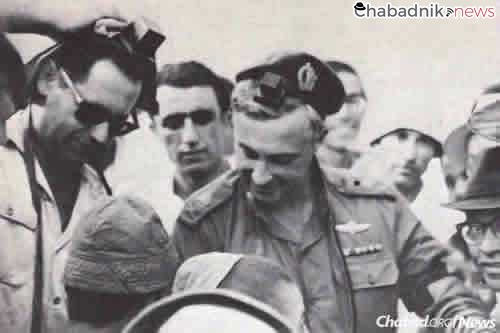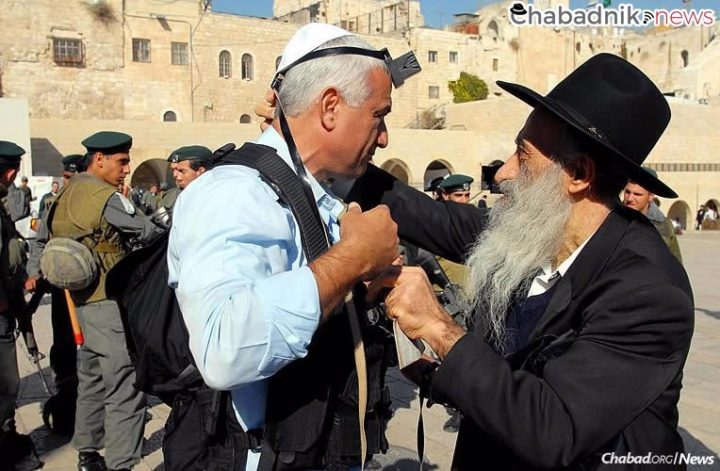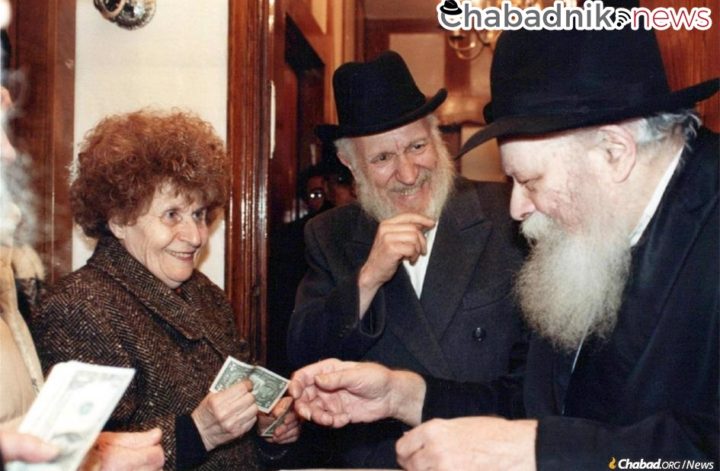More than a half-century later, the impact of the Rebbe’s 1967 worldwide call continues to grow
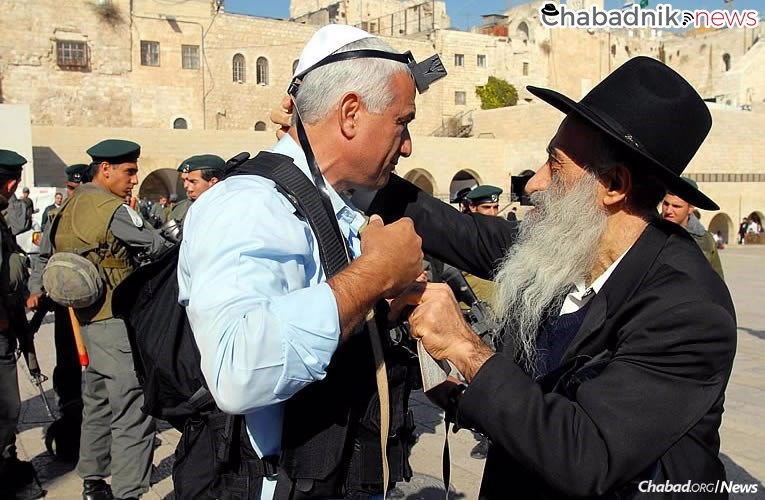
First of a two-part series on the Six-Day War. The second article, ‘Before the Six-Day War: A Lone Voice Reassures a Fearful Jewish People’, can be read here.
It was the morning of June 7, 1967, the third day of the Six-Day War. After a long night of battle on the streets of Jerusalem, an eerie quiet enveloped the ancient city. With fresh orders to take the Old City, Israeli paratroopers blew open the great wooden doors of Lion’s Gate and entered, making their way through the narrow alleys to the Temple Mount, site of the First and Second Temples. Despite the Temple Mount’s holiness, it was not the Jewish soldiers’ true destination. They sought the Kotel Hamaaravi, the Western Wall, where Jews had prayed for 2,000 years, but where no Jew has been allowed during the past two decades of Jordanian rule.
Finding a path, they descended a small staircase to the wall below.
The alley in front of the Western Wall was barely 15 feet wide, but was soon flooded with Israeli paratroopers—religious and non-religious, kipah-wearers and kibbutzniks. Photos and film of that day depicted battle-hardened men breaking down in tears as they encountered the Kotel, burying their faces in the enormous Herodian stones. A shofar was blown. Soldiers prayed, even those not used to doing so.
One of the paratroopers, the late Knesset member and activist Hanan Porat, remembered a non-religious kibbutznik asking him what prayer to recite. “Say Shema,” Porat answered him, recounting the moment in the 2007 PBS documentary “Six Days in June.”
“I do not know how to say it,” the young kibbutznik responded.
“I told him to repeat after me, and I said ‘Shema!’ and he shouted ‘Shema!’ recalled Porat. “Believe me, I do not know if I ever heard a Shema like that in my life.”
Less than a week later, on Shavuot, the Western Wall plaza opened to the public, allowing Jews to approach the remnants of the Temple Mount’s retaining wall unimpeded for the first time in two millennia.
The first morning after Shavuot, four Chabad-Lubavitch Chassidim stationed themselves at the wall with tefillin, offering throngs of Jews the opportunity to transform their raw emotions into concrete action. The men were on the front lines of Chabad’s newly-launched Tefillin Campaign, which the Rebbe—Rabbi Menachem M. Schneerson, of righteous memory—had initiated just days before war started.
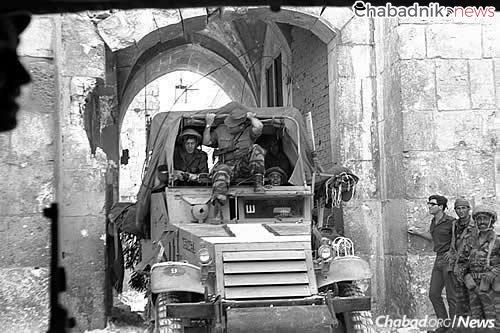
The Tefillin Campaign
It had been on Saturday, June 3—the Shabbat prior to the Six-Day War—that the Rebbe first directed his followers to put on tefillin with Jewish men around the world, placing special emphasis on soldiers in the Israel Defense Forces. In calling on soldiers to perform the mitzvah, the Rebbe quoted the verse “the nations of the world shall see that the name of G‑d is upon you, and they will fear you,” adding that the Talmud explains this “refers to tefillin.”
With the war over and the Kotel liberated, hundreds of men lined up to don the black boxes, wrap their forearms in the soft leather straps, and connect their hearts and minds in the service of G‑d, and themselves, with their ancestors before them. By the end of November 1967, The Boston Globe reported that “more than 400,000 members of the Jewish faith are estimated to have observed the commandment to wear Phylacteries—tefillin in Hebrew—at the city’s Western, formerly known as the ‘Wailing’ Wall.”
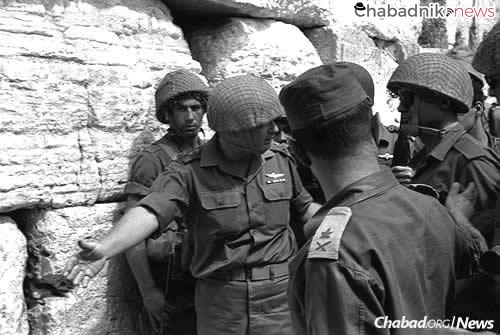
Rabbi Tuvia Blau, a senior Chabad rabbi in Jerusalem, was one of the original four men at the wall. “The whole Jewish world was coming there,” he recalls. “A Jew would come, he’d put on a yarmulke and write a letter, but it was the tefillin that connected him to the place. The Shema Yisroel he said. We saw that.”
Rabbi Yosef Gopin, a 16-year-old boy at the time, spent the war in Jerusalem helping his older sister while his brother-in-law was at the front. Like Blau, Gopin came to the Western Wall for the first time on the day after Shavuot. “I saw a Lubavitcher approach a group of high-ranking officers and offer them to put on tefillin. The most senior one put them on and suddenly ran to the Kotel and started crying. Then he came back and gave an order to the officers with him to put on tefillin and pray as well.”
Much has changed in the 50 years since Israel miraculously won the Six-Day War and liberated Jerusalem, but the Chabad tefillin booth at the Kotel remains much the same, offering hundreds of thousands of Jews a year—millions over the years—the chance to pray in tefillin at one of the holiest sites in Judaism, many for the first time.
That the wall and tefillin go hand in hand is a given today—experienced by Jewish soldiers, celebrities, locals, tourists—and the stand itself appears regularly in documentaries, television programs and other video footage on Israel.
The Holiness of the Holy Land and the Western Wall
The Jewish people’s surprise victory in the face of overwhelming odds stunned the world. At the same time, Jews everywhere were elated—a feeling heightened and given expression to by the poignant images of Israeli paratroopers weeping at the Western Wall, staring at it in awe and wonder.
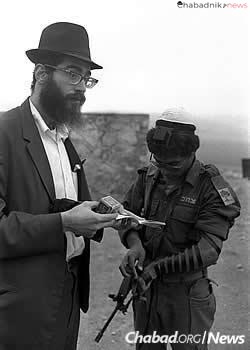
The holiday of Shavuot was the first time that anyone could visit the Kotel, with thousands of Jewish pedestrians making their way through the Old City via a road built by Israeli army engineers from Mount Zion. Only two days after the ceasefire, Israeli patrols spent their holiday in search of remaining Arab snipers shooting sporadically from positions within the Old City.
Although Jews had received various degrees of access to the Western Wall prior to 1948, all of its rulers—from the Romans to the Mamluks to the Ottomans to the British—had placed strictures on what Jews could and could not do at their holy site. Benches and tables were mostly banned; the British forbade the blowing of the shofar and tore down the traditional mechitza barrier that divides men and women at prayer. Now, after centuries of foreign occupation, the Kotel was in Jewish hands. Even before the war was over, Israel began clearing the area in front of it for a plaza.
“I remember powerful but conflicting emotions converging. Not only sitting with my father in anguish about the possibility of another Holocaust [before the war], but also standing at the Western Wall and seeing him become a religious Jew again,” author Yossi Klein Halevi recently told the Israeli publication Fathom. Klein Halevi’s father was a Hungarian Holocaust survivor who carried the experience with him and grappled with his relationship with G‑d, “yet at the Western Wall my father made his peace with God, and became a devout Jew. What happened to my father also played out in the Jewish people.”
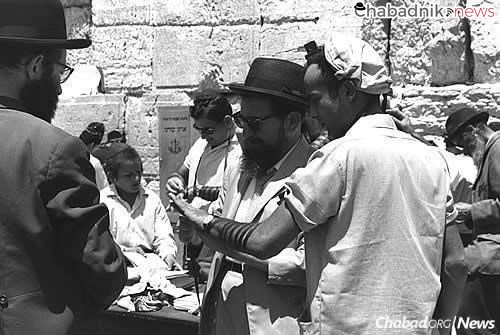
In New York, the Rebbe spoke directly to the emotional images being broadcast from Jerusalem. The Jewish people are visibly united as one nation under G‑d, the Rebbe stated; how else to explain the moving tears of such a cross-spectrum of Jews when encountering the Kotel?
“One would think the Kosel Hamaaravi is an old, devastated wall; there are buildings far more beautiful and more strategic than the Western Wall,” he exclaimed. “It should have been that those who pray should go to the wall and those who wish to see old buildings” go elsewhere.
“But we see that for them, too, is apparent the holiness of the Holy Land at the Western Wall, and they forget about all else. Because if not, there would be no reason to go to this place and shed tears there—certainly not to cry in so public a manner, to the point where if one would try to separate him from the Kosel Hamaaravi, he would not let!”
The response to tefillin was overwhelming. Two weeks after the work had begun, Lubavitch Youth Organization in Kfar Chabad, which was responsible for the new tefillin campaign nationwide, received a letter from the Rebbe’s secretariat containing his specific instructions for the Kotel.
“The Rebbe suggests that if possible a permanent booth be arranged at the Kotel for the putting on of tefillin, of course with permission from the appropriate authorities,” the letter reads. It continues to state that papers containing the blessings for tefillin and the Shema prayer be printed in a small format, and that tefillin be offered for sale and checked at a discounted price.

According to Blau, official permission came a short time later from the first rabbi of the Western Wall, Rabbi Meir Yehuda Getz, who arranged that Chabad’s presence there be formally recognized. For decades, the tefillin stand was run by the late Rabbi Moshe Weber. Fifty years later, the booth remains in operation, with several full-time staff fluent in a number of languages stationed there literally from sunrise to sunset.
“It’s nice that the rabbis there are not insistent, not intrusive, but are there to assist anyone who wants to go further than just putting a message in the wall,” says Silicon Valley venture capitalist and philanthropist Irwin Federman. “I enjoyed putting the tefillin on there. It’s something I don’t do very often, but it reacquainted me with the services of my youth.”
“We meet people every day who would not put on tefillin anywhere, but will do it here at the wall,” attests Rabbi Shmulie Weiss, an Englishman who has greeted English speakers at the Kotel tefillin booth for the last 10 years. “It’s the holiest place in the world.”
